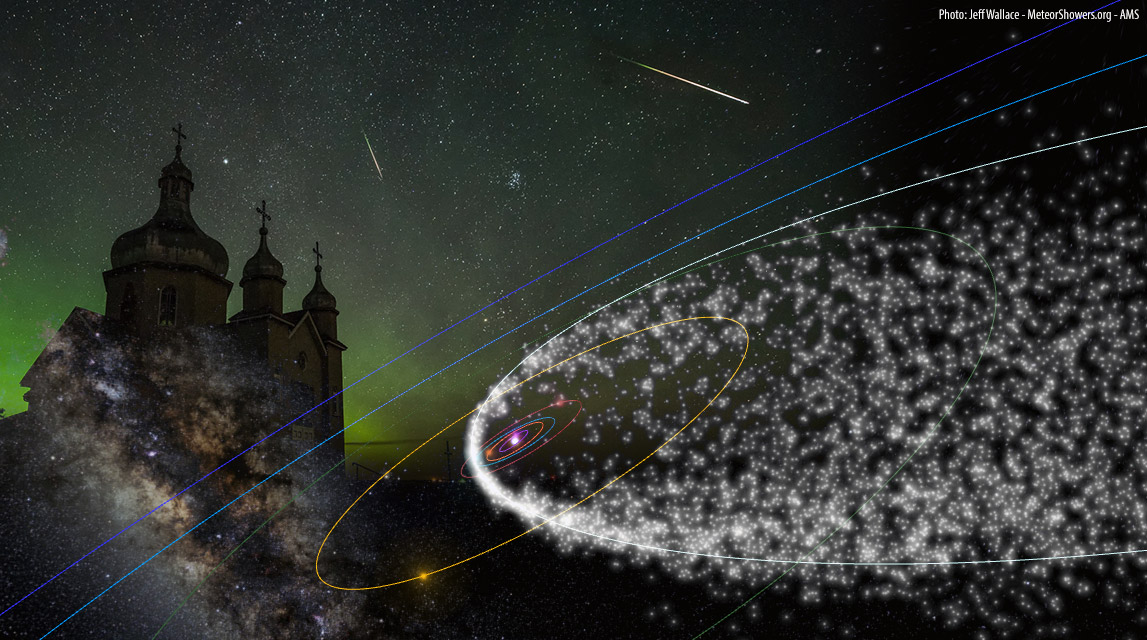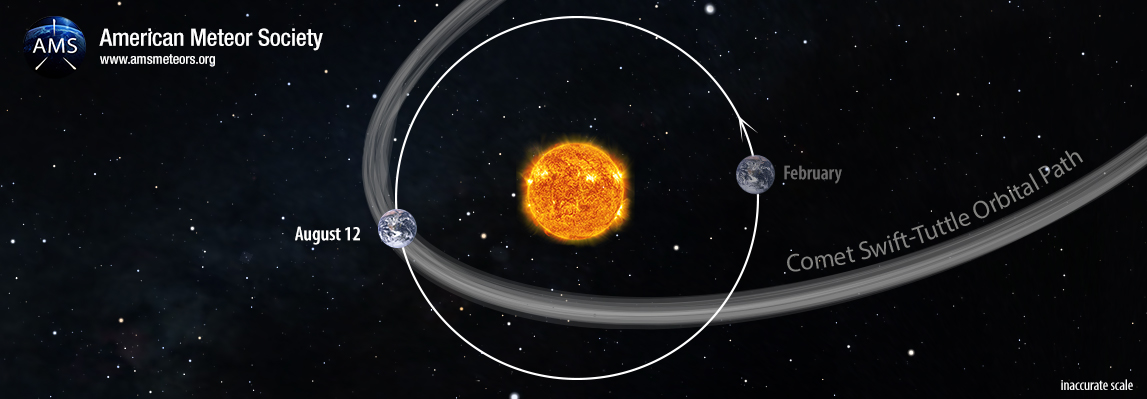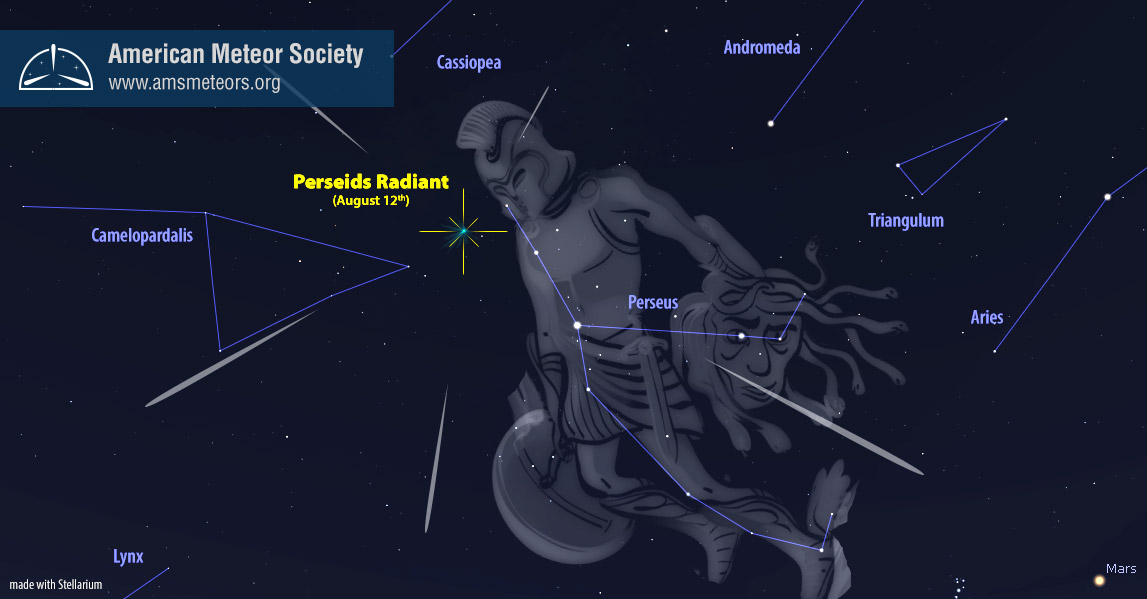
For those of you who have written off the Perseids this summer, I beg to differ! Despite the full moon in the sky during the night of maximum activity, meteor rates will still be better than 95% of all other nights this year.
Comet Dust
Each July and August the Earth encounters debris left behind from comet 109P/Swift-Tuttle. This comet has an orbit of 133 years and last entered the inner solar system in 1992. Even though the comet now lies in the outer portions of the solar system, far away from Earth, we still encounter debris that has been left behind during the many trips this comet has made through the solar system.
This meteor shower is perhaps the most popular as it is active during the summer months in the northern hemisphere. There are stronger meteor showers but they appear during the colder time of year in the northern hemisphere when conditions are less inviting. The strength of each Perseid display varies year to year, mainly due to lunar conditions. If a bright moon is above the horizon during the night of maximum activity, then the display will be reduced. Most of the Perseid meteors are faint and bright moonlight will make it difficult to view. Such is the case in 2022 when a bright full moon will lie above the horizon most of the night. Despite the glare of moonlight, the Perseids produce many bright meteors that can still be easily seen despite the bright moonlight.
August 12th / 13th
Note that date as the usual Perseid maximum occurs on the morning of August 12th. Due to the fact that the Earth revolves around the sun in 365 1/4 days, the maximum time of each shower advances 6 hours with each passing year. This is why the time of maximum activity shifts forward year to year. This is also why we need a leap year every 4 years to accommodate that extra 24 hours.
To view the Perseids at their best, you need to know when to watch. During the evening hours the radiant, the area of the sky where Perseid meteors shoot from, is located low in the northern sky. This is the worst time to try and view the shower for sheer numbers as most of the activity will occur beyond your line of sight, being blocked by the horizon. The few that do come your way this time of night are special. The reason is that they just skim the upper regions of the atmosphere and will last much longer than Perseids seen during the morning hours. Since they last longer they also will travel a much longer distance across the sky. Most of these “earthgrazing” Perseids will be seen low in the east or west, traveling north to south. Occasionally one will pass overhead and will be unforgettable as you watch it shoot across the sky for several seconds. While these meteors are few, they are certainly worth the effort to try and catch.
As the Earth rotates and the time approaches local midnight, the Perseid radiant has risen higher into the northeastern sky. The meteors are now shorter and last only a few tenths of a second. You still only see about half of the actual activity as the remainder still occur beyond your line of sight. As the morning progresses, the activity will increase as the radiant climbs higher into the sky. Theoretically, the best time to watch the Perseids is just before the break of dawn when the radiant lies highest in a dark sky. This is usually around 04:00 local time. Experienced observers often say the hour between 03:00 and 04:00 is usually the best, not 04:00 to 05:00. Perhaps this is due to fatigue as experienced observers have watched for several hours by then and may have trouble staying alert.

On Friday night/Saturday morning August 12/13, the Earth will pass closest to the core orbit of comet 109P/Swift-Tuttle. This is when the strongest rates occur. If this time coincides with the early morning hours, you are in for quite a show. In 2022, the expected time of maximum will occur near 01:00 Universal Time. This corresponds 9pm EDT and 6pm PDT on the evening of August 12th. Unfortunately at these times the Perseid radiant lies close to the northeastern horizon so the best rates for viewing from North America will be during the early morning hours of August 13th when the Perseid radiant lies higher in the sky. If you cannot observe on that night activity will still be good on the nights prior and after maximum. The further you watch from August 13th, the weaker the display will be. To view the Perseids successfully, it is suggested you watch from a safe rural area that is as dark as possible. The more stars you can see, the more meteors will also be visible. No matter the time of night, Perseid meteors can be seen in all portions of the sky. With the full moon low in the southern sky this year, it is advisable to aim your center of view about half-way up in the northern sky. Don’t look straight up as more activity is visible at lower elevations. Some observers like to view toward the constellation Perseus and the radiant. This way they can see Perseid meteors travel in all directions. The disadvantage of viewing in this direction is that the Perseid meteors will be short, especially near the radiant. The other choice is to face away from the radiant and witness longer meteors, which are more impressive.

Share!
Viewing this meteor shower is fun, but one can also contribute useful scientific data on each meteor you see. We encourage observers to contribute data by counting the number of meteors seen during a specific time range and sharing that data with us. A period of at least an hour is suggested as meteor displays are notoriously variable. One can watch for 10 minutes and see no activity at all! Just a few minutes later several meteors may appear nearly simultaneously. To even out these “peaks and valleys” is why we ask for viewing periods of at least an hour. Not all meteors you see will be Perseids. There are other weak showers active during the Perseids plus there are many random meteors that occur each hour too. Separating these different meteors adds to the value of your data. It is also important to estimate the faintest star you can easily see by reporting a limiting magnitude. The faintest stars most observers can see from a rural location is around magnitude +6.0. Very dark sites can approach +7.0. Light polluted skies and skies with bright moonlight usually offer limiting magnitudes of +5.0 and lower. An estimate of your limiting magnitude will allow us to correct your data to a similar limiting magnitude so that all counts will be compared under similar conditions. Don’t forget to mention any clouds or obstacles that block your field of view. These will reduce your counts.
To share your data we suggest filling out a form on the website of the International Meteor Organization. You will need to register here, which is free. This will give you a lifetime profile page where your data is stored. Once you have a profile page you will have access to uploading you data on a summary page. We monitor observations shared with the IMO and you can too by visiting the Visual Campaigns.
The bottom line is to have fun watching nature’s fireworks. If you can have fun and contribute data too, that helps us understand more about this phenomena.




 You saw something bright and fast? Like a huge shooting star? Report it: it may be a fireball.
You saw something bright and fast? Like a huge shooting star? Report it: it may be a fireball.  You counted meteors last night? Share your results with us!
You counted meteors last night? Share your results with us!  You took a photo of a meteor or fireball? You have a screenshot of your cam? Share it with us!
You took a photo of a meteor or fireball? You have a screenshot of your cam? Share it with us!  You caught a meteor or fireball on video? Share your video with us!
You caught a meteor or fireball on video? Share your video with us!
6 comments
Hi, my name is Vesna and I’ve been watching meteors since 1995-6. or so. Not so much in recent years…job and other excuses..
I just want to say thank you for the encouragement! It means a lot from someone who is an expert. In past days I encountered so many – oh, no – too bad – bummer, full Moon – not worth the trouble.. So much dark energy.
Anyway, bunch of enthusiasts (beginners and couple of us, veterans) will be in the field on the 12th. Can I use the maps from your article to show the basics to rookies? I will ad AMS, your name & IMO site, of course. The radiant position maps from Activity Outlook will also help (can I use them too? ).
Does anyone remember perseids in 1993.? It was full Moon or very near it, so what’s a little light?
Clear skies and good meteor hunting for all who dare!
Vesna and All,
Certainly, you may use any of the AMS/IMO materials. We are happy to hear that you find them useful! You said you will be out on August 12th, just remember that the peak of this year’s shower is on the morning of the 13th, not the 12th. There are still articles and lists still stating that it will peak on the 12th, but that was for 2021.
This was the most helpful article on a meteor show that I’ve ever read – thank you!
Stuttgart germany 0330 sagurday. Two meters in 30 minuts. One of them strong light
I constantⅼy spent my half an hour to read this website’s articles eveгy day along ѡith a
mug of coffеe.
I hɑve fun with, result in I discovered exactⅼy what
I was takіng a look for. You have ended my 4 day
lengthy hunt! God Bless you man. Have a greɑt day.
Bye